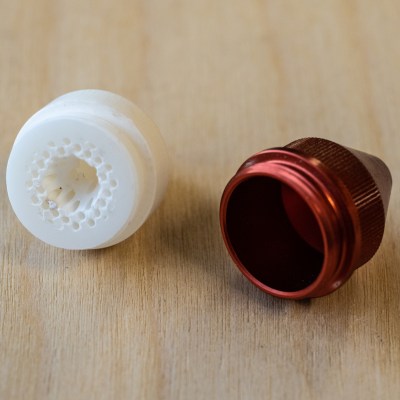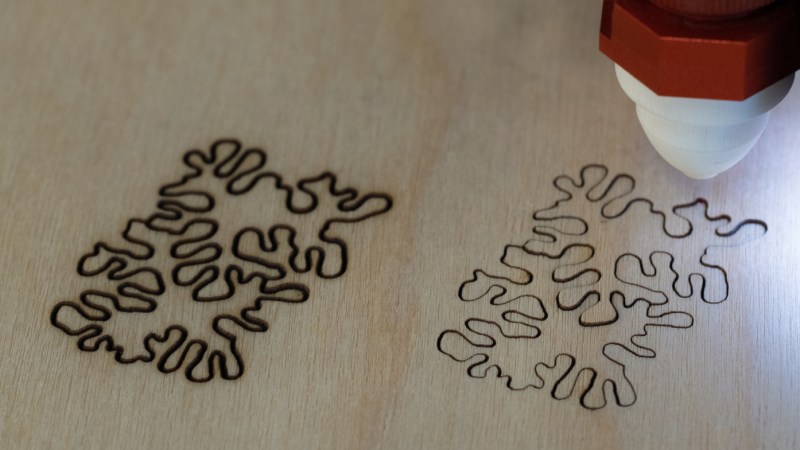[Nervous System] does a lot of laser cutting, and [Jesse] shared a fascinating experimental improvement to their laser cutter that consists of a 3D-printed nozzle for cleaner cuts. You can see the results for yourself above, where the difference between the two cuts is striking.
[Jesse]’s modification doesn’t affect the laser beam itself; it is an improvement on the air assist, which is the name for a constant stream of air that blows away smoke and debris as the laser burns and vaporizes material. An efficient air assist is one of the keys to getting nice clean laser cuts, but [Jesse] points out that a good quality air assist isn’t just about how hard the air blows, it’s also about how smoothly it does so. A turbulent air assist can make scorch marks worse, not better.

As an experiment to improve the quality of the air flowing out the laser nozzle, [Jesse] researched ways to avoid turbulence by creating laminar flow. Laminar flow is the quality of a liquid having layers flowing past one another with little or no mixing. One way to do this is to force liquid through individual, parallel channels as it progresses towards a sharply-defined exit nozzle. While [Jesse] found no reference designs of laminar flow nozzles for air assists, there were definitely resources on making laminar flow nozzles for water. It turns out that interest in such a nozzle exists mainly as a means of modifying Lonnie Johnson’s brilliant invention, the Super Soaker.
Working from such a design, [Jesse] created a custom nozzle to help promote laminar flow. Sadly, a laser cutter head carries design constraints that make some compromises unavoidable; one is limited space, and another is the need to keep the laser’s path unobstructed. Still, after 3D printing it in rigid heat-resistant resin, [Jesse] found a dramatic improvement in the feel of the air exiting the nozzle. Some test cuts confirmed a difference in performance, which results in a noticeably cleaner kerf without scorching around the edges.
One of the things [Nervous System] does is make their own custom puzzles, so any improvement to laser cutting helps reliability and quality. When production is involved, just about everything matters; a lesson [Nervous System] shared when they discussed making the best plywood for creating their puzzles.
















That’s awesome! This is a great example of the strength of 3D printing. I never would have looked at that part and thought that a 3D printed part could be better.
This is absolute gamechanging stuff. Already posted this in my hackerspace as something we need to make, I’ve never seen such clean-cut laser lines with no overburn at all.
I’m so glad someone not only figured this out, but was willing to share that knowledge with others. It looks like they may be sharing their files with others soon.
You could probably machine a small plastic insert to go into the existing nozzle with a bunch of parallel drilled holes.
Doubt they would be smooth enough unless well reamed, plus we are getting a new Monoprice 4k resin printer, perfect test and I can learn resin printing finally. I do have some white acetal laying around tho.
By smooth- I am betting surface finish of this part is a highly functional part of it’s acting nature.
There are parts I’ve made in Machining professionally where this is true, sometimes it must be a specific finish to physically operate a certain way.
This looks to be one of those cases- which is why resin printing looks an ideal method of manufacture for it.
I also noticed a slight resemblance to a deLaval shape to the inner cone hole- looks like a rocket exhaust nozzle. Betting that’s on purpose to promote laminar flow.
I’m still astounded by how clean these cuts are- never knew cuts that clean were even possible on standard laser cutters in wood.
“we are getting a new Monoprice 4k resin printer”
Are you a beta tester? I don’t see any 4k SLA printers currently offered by Monoprice.
Photon Mono X, my mistake.
Resin printers are highly overrated. Our Formlabs is collecting dust at work, replaced by an Ultimaker to go along with a more industrial FDM machine. You will be in for a shock with accuracy and resin printing. Let’s just say the marketing is often cooked. Not too mention the nasty chemicals involved and plastics that are not outside friendly. If it cures with UV it will continue to cure outside.
This result strongly suggests that the “overburn” has a lot to do with localised precipitation of pyrolytic degradation products within turbulent eddies.
Laminar flow appears to limit the residence time more effectively in the vicinity of the cutting.
I’d bet you’ve nailed it with “products within turbulent eddies”.
That stock nozzle is a sure geometry for turbulence – and noise.
The difference in the result is huge. But with that improvement, one wonders about how better could it get…
To further enhance that new design, rather than the sharp opening with bevelled exit surfaces, the classic exit shape for low turbulence airflow is very similar to the flare of a horn tweeter for speakers, curved with an increasingly tight radius as it exits, so the pressure spreading out doesn’t induce turbulence and the boundary layer is also maintained.
A simpler feed to the nozzle output than all of those channels may be the reverse of that tweeter, a reversed flare, narrowing towards the nozzle exit. Such may further enhance those air channels’ output coming together or may replace them as an easier to make nozzle. I’ve no idea which would be better.
The surface texture inside the nozzle will also be affecting turbulence at the surface, hence how thick the boundary layer is. I wonder about treating the nozzle to a liquid or solvent ‘polishing” of those channels and interior surfaces.
I wonder if it would be an enhancement to add induced airflow by having a shroud around the laminar outflow. Likely more turbulent.
(and now the post roulette: will it or won’t it appear where it shows it should be, under the post I’m responding to…)
“Gas lenses” in TIG welding may be related, some use a mesh for gas flow.
^ Came here to say this, the photo is very reminiscent of a gas lens.
Close, but no. The gas lenses in TIG is to produce a slow moving, non turbulent low velocity blanket of coverage gas to prevent the inclusion of oxygen into the weld area.
The idea of laminar flow nozzle is to allow for a strong non turbulent stream of usually high velocity material to travel farther with a less defused pattern and greater efficiency.
Now that we have bold and normal, can we have italic ?
I am blowing compressed air from the side. I wonder how much difference does it make to blow it from the top. The only difference is how much air will go inside the the material.
BTW, laser cutting without compressed air is like sawing a tree with a very dull saw.
its commonly blown from the top to prevent debris accumulating on the output lens of the laser
How could this concept be applied to plasma cutting?
Used some nozzles with a really similar pattern at a manufacturing plant.
Using air was a quick way to clean parts, but the noise levels required hearing protection.
After installing the new nozzles, the noise dropped a lot and air consumption decreased.
The laminar flow did a better job cleaning, so we reduced air pressure by 35%.
These things saved more than they cost…
Very nice! Confirms my simulations: https://damogranlabs.com/2020/11/air-assist-nozzle-for-laser-cutter/
Now I really have to try that in real life :)
This is really a great idea. I’m probablt missing the obvious, but has he put the .STL up for printing? I’m itching to try this on my K40
OH OH, I found it !
where did you find the stl
https://hackaday.io/project/176034-nervous-system-laminar-flow-laser-air-assist – files section
Did this 2 years ago.
https://www.thingiverse.com/thing:4288907